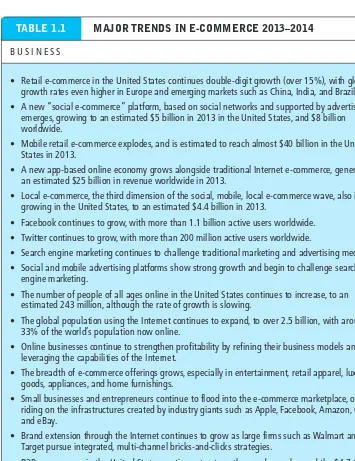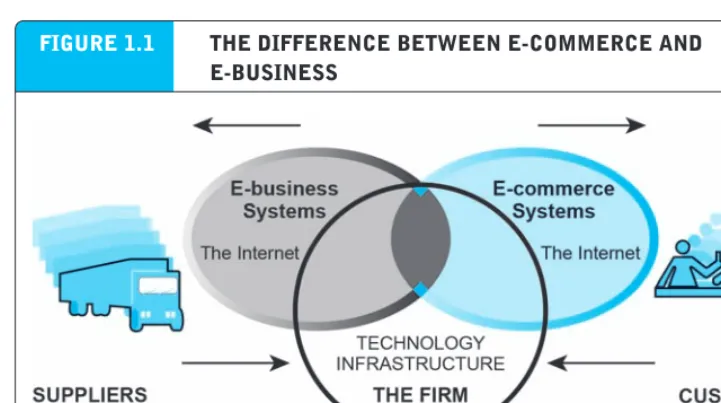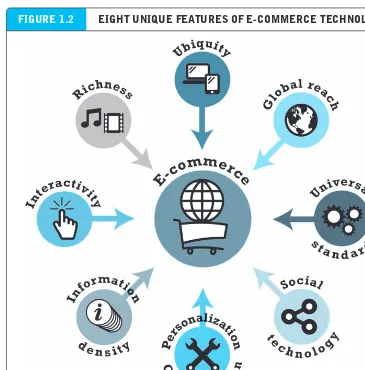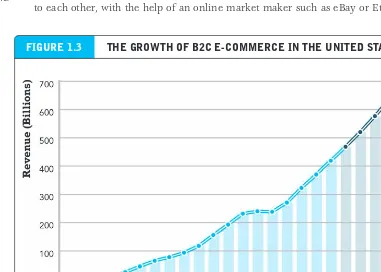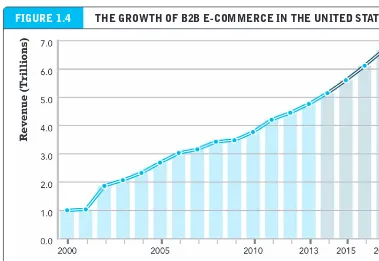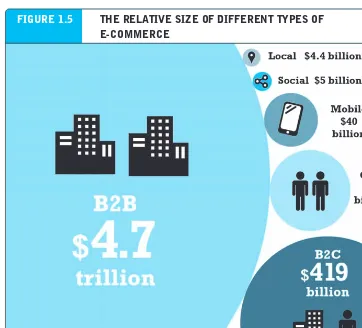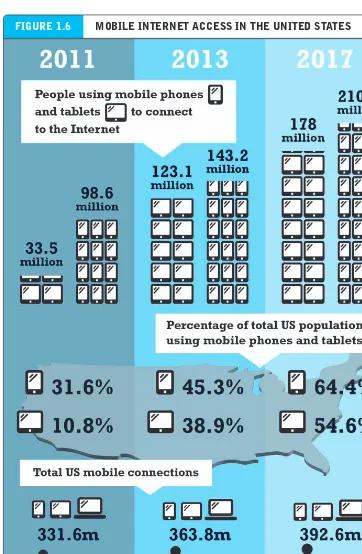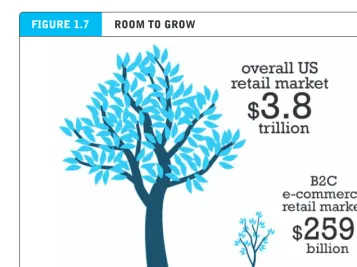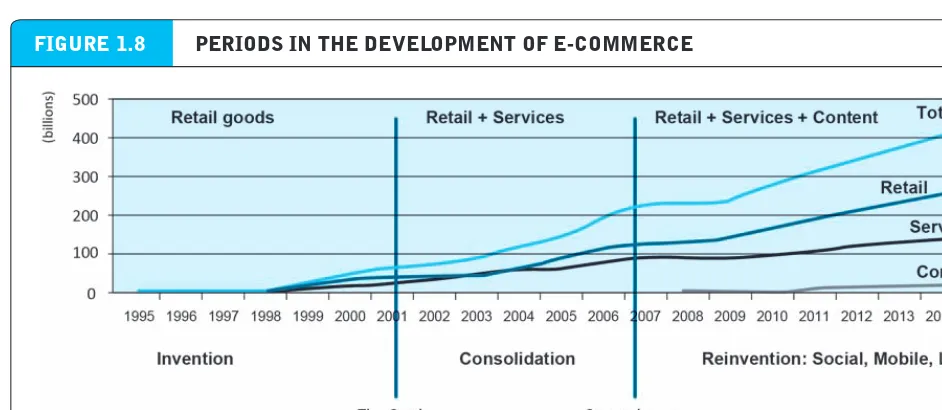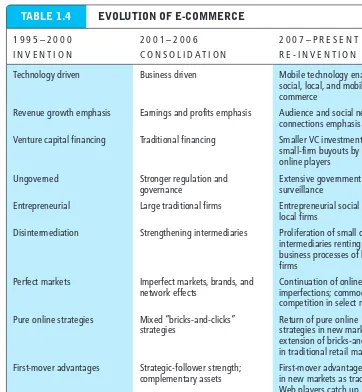Complete Listing of Chapter Opening Cases, Insight Cases,
E-commerce in Action Cases, and Case Studies
CHAPTER 1
THE REVOLUTION IS JUST BEGINNING
Opening Case: Pinterest: A Picture Is Worth a Thousand Words Insight on Technology: Will Apps Make the Web Irrelevant? Insight on Business: Start-Up Boot Camp
Insight on Society: Facebook and the Age of Privacy Case Study: The Pirate Bay: Searching for a Safe Haven
CHAPTER 2
E-COMMERCE BUSINESS MODELS AND CONCEPTS
Opening Case: Twitter’s Business Model
Insight on Society: Foursquare: Check Your Privacy at the Door Insight on Business: Crowdfunding Takes Off
Insight on Technology: Battle of the Titans: Music in the Cloud Case Study: Pandora and the Freemium Business Model
CHAPTER 3
E-COMMERCE INFRASTRUCTURE: THE INTERNET, WEB, AND MOBILE
PLATFORM
Opening Case: Google Glass: Augment My Reality
Insight on Society: Government Surveillance and Regulation of the Internet Insight on Technology: Is HTML5 Ready for Prime Time?
Insight on Business: The Apps Ecosystem
CHAPTER 4
BUILDING AN E-COMMERCE PRESENCE: WEB SITES, MOBILE SITES, AND APPS
Opening Case: USA Today Redesigns
Insight on Business: Curly Hair and Appillionaires Insight on Society: Designing for Accessibility Insight on Technology: Building a Mobile Presence Case Study: Orbitz Charts Its Mobile Trajectory
CHAPTER 5
E-COMMERCE SECURITY AND PAYMENT SYSTEMS
Opening Case: Cyberwar: MAD 2.0 Insight on Business: We Are Legion
Insight on Technology: Think Your Smartphone Is Secure? Insight on Society: Bitcoin
Case Study: Online Payment Marketplace: Goat Rodeo
CHAPTER 6
E-COMMERCE MARKETING AND ADVERTISING CONCEPTS
Opening Case: Video Ads: Shoot, Click, Buy
Insight on Business: Are the Very Rich Different From You and Me? Insight on Technology: The Long Tail: Big Hits and Big Misses
Insight on Society: Every Move You Take, Every Click You Make, We’ll Be Tracking You Case Study: Instant Ads: Real-Time Marketing on Exchanges
Kenneth C. Laudon
Carol Guercio Traver
New York University
Azimuth Interactive, Inc.
E-commerce
business. technology. society.
T e n T H e d i T i o n
Boston Columbus Indianapolis New York San Francisco Upper Saddle River Amsterdam Cape Town Dubai London Madrid Milan Munich Paris Montreal Toronto
Credits and acknowledgements borrowed from other sources and reproduced, with permission, in this textbook appear on page C-1.
Microsoft and/or its respective suppliers make no representations about the suitability of the information contained in the documents and related graphics published as part of the services for any purpose. All such documents and related graphics are provided “as is” without war-ranty of any kind. Microsoft and/or its respective suppliers hereby disclaim all warranties and conditions with regard to this information, including all warranties and conditions of merchantability, whether express, implied or statutory, fitness for a particular purpose, title and non-infringement. In no event shall Microsoft and/or its respective suppliers be liable for any special, indirect or consequential damages or any damages whatsoever resulting from loss of use, data or profits, whether in an action of contract, negligence or other tortious action, aris-ing out of or in connection with the use or performance of information available from the services. The documents and related graphics contained herein could include technical inaccuracies or typographical errors. Changes are periodically added to the information herein. Microsoft and/or its respective suppliers may make improvements and/or changes in the product(s) and/or the program(s) described herein at any time. Partial screen shots may be viewed in full within the software version specified.
Microsoft® and Windows®, and Microsoft Office® are registered trademarks of the Microsoft Corporation in the U.S.A. and other countries. This book is not sponsored or endorsed by or affiliated with the Microsoft Corporation.
Copyright © 2014, 2013, 2012 by Kenneth C. Laudon and Carol Guercio Traver.
Published by Pearson Education, Inc., One Lake Street, Upper Saddle River, New Jersey 07458. All rights reserved. Manufactured in the United States of America. This publication is protected by copyright, and permission should be obtained from the publisher prior to any prohibited reproduction, storage in a retrieval system, or transmission in any form or by any means, electronic, mechanical, photocopying, recording, or likewise. To obtain permission(s) to use material from this work, please submit a written request to Pearson Education, Inc., Permissions Department, One Lake Street, Upper Saddle River, New Jersey 07458, or you may fax your request to 201-236-3290.
Many of the designations by manufacturers and sellers to distinguish their products are claimed as trademarks. Where those designations appear in this book, and the publisher was aware of a trademark claim, the designations have been printed in initial caps or all caps.
ISBN 10: 0-13-302444-X ISBN 13: 978-0-13-302444-9 Library of Congress Cataloging-in-Publication Information Is Available
Editor In Chief: Stephanie Wall Executive Editor: Bob Horan
Program Manager Team Lead: Ashley Santora Program Manager: Denise Vaughn
Editorial Assistant: Kaylee Rotella
Executive Marketing Manager: Anne K. Fahlgren Project Manager Team Lead: Judy Leale
Project Manager: Karalyn Holland Operations Specialist: Michelle Klein Creative Director: Blair Brown
Sr. Art Director: Janet Slowik Cover Designer: DePinho Design Cover Image: Shutterstock VLADGRIN Media Project Manager: Lisa Rinaldi Full Service Project Management: Azimuth
Interactive, Inc.
Composition: Azimuth Interactive, Inc. Printer/Binder: Edwards Brothers Malloy
Cover Printer: Lehigh-Phoenix Color/Hagarstown Text Font: ITC Veljovic Std. Book, 9.5pt
iii
E-commerce. Business. Technology. Society. 10E provides you with an in-depth introduc-tion to the field of e-commerce. We focus on concepts that will help you understand and take advantage of the evolving world of opportunity offered by e-commerce, which is dramatically altering the way business is conducted and driving major shifts in the global economy.
Just as important, we have tried to create a book that is thought-provoking and current. We use the most recent data available, and focus on companies that you are likely to encounter on a daily basis in your everyday life, such as Facebook, Google, Twitter, Amazon, YouTube, Pinterest, eBay, and many more that you will recognize, as well as some exciting startups that may be new to you. We also have up-to-date coverage of the key topics in e-commerce today, from privacy and piracy, to govern-ment surveillance, cyberwar, social, local, and mobile marketing, Internet sales taxes, intellectual property, and more. You will find here the most up-to-date and compre-hensive overview of e-commerce today.
The e-commerce concepts you learn in this book will make you valuable to potential employers. The e-commerce job market is expanding rapidly. Many employ-ers expect new employees to undemploy-erstand the basics of e-commerce, social and mobile marketing, and how to develop an e-commerce presence. Every industry today is touched in at least some way by e-commerce. The information and knowledge you find in this book will be valuable throughout your career, and after reading this book, we expect that you will be able to participate in, and even lead, management discus-sions of e-commerce for your firm.
wHaT’s new in THe TenTH ediTion
new Chapter on social, Mobile, and Local Marketing
Given the growing importance of social, mobile, and local marketing in e-commerce, we have written an entirely new chapter devoted to providing an in-depth examina-tion of these topics. In this new chapter, you will learn how companies are using Facebook, Twitter, and Pinterest for social marketing, how to begin a social marketing campaign and how to measure results for each of these platforms. We provide similar examination of mobile and local and location-based marketing as well.
new infographics
A variety of infographics throughout the book provide a more visual and intuitive access to concepts and information. Infographics make it easier to see and remember patterns and relationships than traditional charts and graphs.
iv P r e f a c e
Currency
The 10th edition features all new or updated opening, closing, and “Insight on” cases. The text, as well as all of the data, figures, and tables in the book, have been updated through October 2013 with the latest marketing and business intelligence available from eMarketer, Pew Internet & American Life Project, Forrester Research, com-Score, Gartner Research, and other industry sources.
what’s new in e-commerce 2014
E-commerce today is greatly different from e-commerce only five years ago. The iPhone was introduced in 2007. The iPad tablet was first introduced in 2010 and has already gone through several generations! The smartphone and tablet devices have changed e-commerce into a social, local, and mobile experience. The 10th edition spotlights the following themes and content:
Headlines
• Social, Mobile, Local: We have included an entirely new chapter describing social, mobile, and local marketing. Content about social networks, the mobile platform and local e-commerce appears throughout the book.
» Social networks such as Facebook, Twitter, Pinterest, and LinkedIn continue their rapid growth, laying the groundwork for a social network marketing plat-form
» The mobile platform composed of smartphones and tablet computers takes off and becomes a major factor in search, marketing, payment, retailing and ser-vices, and online content. Mobile device use poses new security and privacy issues as well.
» Location-based services lead to explosive growth in local advertising and mar-keting.
• Online privacy continues to deteriorate, driven by a culture of self-revelation and powerful technologies for collecting personal information online without the knowledge or consent of users.
• Internet security risks increase; cyberwarfare becomes a new way of conducting warfare among nation-states and a national security issue.
Business
• E-commerce revenues surge after the recession.
• Internet advertising growth resumes, at a faster rate than traditional advertising. • Social marketing grows faster than traditional online marketing like search and
display advertising.
• E-books take off and expand the market for text, supported by the iPad, Kindle, Nook, and iPhone.
P r e f a c e v
• “Free” and “freemium” business models compete to support digital content. • New mobile payment platforms emerge to challenge PayPal.
• B2B e-commerce exceeds pre-recession levels as firms become more comfortable with digital supply chains.
Technology
• Smartphones, tablets, and e-book readers, along with associated software applica -tions, and coupled with 4G cellular network expansion, fuel rapid growth of the mobile platform.
• Investment in cloud computing increases, providing the computing infrastructure for a massive increase in online digital information and e-commerce.
• Cloud-based streaming services for music and video challenge sales of downloads and physical product.
• Software apps fuel growth in app sales, marketing, and advertising; transforming software production and distribution.
• Touch interface operating systems dominate mobile devices. Windows 8 intro -duced with a touch screen interface, mimicking Apple’s iOS and Google Android smartphones.
• The cost of developing sophisticated Web sites continues to drop due to declining software and hardware prices and open source software tools.
• Internet and cellular network capacity is challenged by the rapid expansion in digital traffic generated by mobile devices; the use of bandwidth caps tier-pricing expands.
• Internet telecommunications carriers support differential pricing to maintain a stable Internet; opposed by Net neutrality groups pushing non-discriminatory pricing.
Society
• The mobile, “always on” culture in business and family life continues to grow. • Congress considers legislation to regulate the use of personal information for
behavioral tracking and targeting consumers online.
• States heat up the pursuit of taxes on Internet sales by Amazon and others. • Intellectual property issues remain a source of conflict with significant movement
toward resolution in some areas, such as Google’s deals with Hollywood and the publishing industry, and Apple’s and Amazon’s deals with e-book and magazine publishers.
• P2P piracy traffic declines as paid streaming music and video gains ground, although digital piracy of online content remains a significant threat to Hollywood and the music industry.
vi P r e f a c e
• Venture capital investing in e-commerce explodes for social, mobile, and local soft -ware applications. Crowdfunding becomes a new source of funding for e-com-merce start-ups.
weLCoMe To THe new e-CoMMeRCe
Since it began in 1995, electronic commerce has grown in the United States from a standing start to a $419 billion retail, travel, and media business and a $4.7 trillion business-to-business juggernaut, bringing about enormous change in business firms, markets, and consumer behavior. Economies and business firms around the globe are being similarly affected. During this relatively short time, e-commerce has itself been transformed from its origin as a mechanism for online retail sales into something much broader. Today, e-commerce has become the platform for media and new, unique services and capabilities that aren’t found in the physical world. There is no physical world counterpart to Facebook, Twittter, Google search, or a host of other recent online innovations from Pinterest and iTunes to Tumblr. Welcome to the new e-commerce!
Although e-commerce today has been impacted by the worldwide economic recession, in the next five years, e-commerce in all of its forms is still projected to continue growing at high single-digit rates, becoming the fastest growing form of com-merce. Just as automobiles, airplanes, and electronics defined the twentieth century, so will e-commerce of all kinds define business and society in the twenty-first cen-tury. The rapid movement toward an e-commerce economy and society is being led by both established business firms such as Walmart, Ford, IBM, Macy’s, and General Electric, and newer entrepreneurial firms such as Google, Amazon, Apple, Facebook, Yahoo, Twitter, YouTube, and Photobucket. Students of business and information tech-nology need a thorough grounding in electronic commerce in order to be effective and successful managers in the next decade. This book is written for tomorrow’s managers.
While newer firms such as Facebook, Tumblr, YouTube, Twitter, Pinterest, Flickr, and Square have grown explosively in the last two years and grab our attention, the traditional forms of retail e-commerce and services also remain vital and have proven to be more resilient than traditional retail channels in facing the economic recession. The experience of these firms from 1995 to the present is also a focus of this book. The defining characteristic of these firms is that they are profitable, sustainable, effi-cient, and innovative, with powerful brand names. Many of these now-experienced retail and service firms, such as eBay, Amazon, E*Trade, Priceline, and Expedia, are survivors of the first era of e-commerce, from 1995 to spring 2000. These surviving firms have evolved their business models, integrated their online and offline opera-tions, and changed their revenue models to become profitable. Students must under-stand how to build these kinds of e-commerce businesses in order to help the business firms they manage to succeed in the e-commerce era.
P r e f a c e vii
moving to establish profitable businesses while maintaining rapid growth in reve-nues. In 2013, e-commerce is entering a new period of explosive entrenpreneurial activity focusing on social networks and the mobile digital platform created by smart-phones and tablet computers. These technologies and social behaviors are bringing about extraordinary changes to our personal lives, markets, industries, individual businesses, and society as a whole. In 2012–2013, the stock values of Apple, Google, and Amazon hit new highs, along with many start-ups. E-commerce is generating thousands of new jobs for young managers in all fields from marketing to manage-ment, entrepreneurial studies, and information systems. Today, e-commerce has moved into the mainstream life of established businesses that have the market brands and financial muscle required for the long-term deployment of e-commerce tech-nologies and methods. If you are working in an established business, chances are the firm’s e-commerce capabilities and Web presence are important factors for its success. If you want to start a new business, chances are very good that the knowledge you learn in this book will be very helpful.
BUsiness. TeCHnoLoGY. soCieTY.
We believe that in order for business and technology students to really understand e-commerce, they must understand the relationships among e-commerce business concerns, Internet technology, and the social and legal context of e-commerce. These three themes permeate all aspects of e-commerce, and therefore, in each chapter, we present material that explores the business, technological, and social aspects of that chapter’s main topic.
Given the continued growth and diffusion of e-commerce, all students—regard-less of their major discipline—must also understand the basic economic and business forces driving e-commerce. E-commerce has created new electronic markets where prices are more transparent, markets are global, and trading is highly efficient, though not perfect. E-commerce has a direct impact on a firm’s relationship with sup-pliers, customers, competitors, and partners, as well as how firms market products, advertise, and use brands. Whether you are interested in marketing and sales, design, production, finance, information systems, or logistics, you will need to know how e-commerce technologies can be used to reduce supply chain costs, increase produc-tion efficiency, and tighten the relaproduc-tionship with customers. This text is written to help you understand the fundamental business issues in e-commerce.
We spend a considerable amount of effort analyzing the business models and strategies of “pure-play” online companies and established businesses now employing “bricks-and-clicks” business models. We explore why e-commerce firms fail and the strategic, financial, marketing, and organizational challenges they face. We also dis-cuss how e-commerce firms learned from the mistakes of early firms, and how estab-lished firms are using e-commerce to succeed. Above all, we attempt to bring a strong sense of business realism and sensitivity to the often exaggerated descriptions of e-commerce. As founders of a dot.com company and participants in the e-commerce revolution, we have learned that the “e” in e-commerce does not stand for “easy.”
viii P r e f a c e
and advertising. Chapter 6 discusses “traditional” online marketing formats like search engine marketing, display advertising, and e-mail, as well as various Internet marketing technologies underlying those efforts, and metrics for measuring market-ing success. Chapter 7 provides an in-depth examination of social, mobile, and local marketing, which relies on mobile devices and social networks.
E-commerce is driven by Internet technology. Internet technology, and infor-mation technology in general, is perhaps the star of the show. Without the Internet, e-commerce would be virtually nonexistent. Accordingly, we provide three chapters specifically on the Internet and e-commerce technology, and in every chapter we provide continuing coverage by illustrating how the topic of the chapter is being shaped by new information technologies. For instance, Internet technology drives developments in security and payment systems, marketing strategies and advertis-ing, financial applications, media distribution, business-to-business trade, and retail e-commerce. We discuss the rapid growth of the mobile digital platform, the emer-gence of cloud computing, new open source software tools and applications that enable Web 2.0, and new types of Internet-based information systems that support electronic business-to-business markets.
E-commerce is not only about business and technology, however. The third part of the equation for understanding e-commerce is society. E-commerce and Internet technologies have important social consequences that business leaders can ignore only at their peril. E-commerce has challenged our concepts of privacy, intellectual property, and even our ideas about national sovereignty and governance. Google, Facebook, Apple, Amazon, and assorted advertising networks maintain profiles on millions of shoppers and consumers worldwide. The proliferation of illegally copied music and videos on the Internet, and the growth of social networking sites often based on displaying copyrighted materials without permission, are challenging the intellectual property rights of record labels, Hollywood studios, and artists. And many countries—including the United States—are demanding to control the content of Web sites displayed within their borders for political and social reasons. Tax authorities in the United States and Europe are demanding that e-commerce sites pay sales taxes just like ordinary brick and mortar stores on mainstreet. As a result of these chal-lenges to existing institutions, e-commerce and the Internet are the subject of increas-ing investigation, litigation, and legislation. Business leaders need to understand these societal developments, and they cannot afford to assume any longer that the Internet is borderless, beyond social control and regulation, or a place where market efficiency is the only consideration. In addition to an entire chapter devoted to the social and legal implications of e-commerce, each chapter contains material high-lighting the social implications of e-commerce.
FeaTURes and CoVeRaGe
P r e f a c e ix
work for understanding e-commerce. We analyze e-commerce, digital markets, and e-business firms just as we would ordinary businesses and markets using concepts from economics, marketing, finance, sociology, philosophy, and information sys-tems. We strive to maintain a critical perspective on e-commerce and avoid industry hyperbole.
Some of the important concepts from economics and marketing that we use to explore e-commerce are transaction cost, network externalities, information asym-metry, social networks, perfect digital markets, segmentation, price dispersion, tar-geting, and positioning. Important concepts from the study of information systems and technologies play an important role in the book, including Internet standards and protocols, client/server computing, multi-tier server systems, cloud computing, mobile digital platform and wireless technologies, and public key encryption, among many others. From the literature on ethics and society, we use important concepts such as intellectual property, privacy, information rights and rights management, governance, public health, and welfare.
From the literature on business, we use concepts such as business process design, return on investment, strategic advantage, industry competitive environment, oli-gopoly, and monopoly. We also provide a basic understanding of finance and account-ing issues, and extend this through an “E-commerce in Action” case that critically examines the financial statements of Amazon. One of the witticisms that emerged from the early years of e-commerce and that still seems apt is the notion that e-com-merce changes everything except the rules of business. Businesses still need to make a profit in order to survive in the long term.
Currency Important new developments happen almost every day in e-commerce and the Internet. We try to capture as many of these important new developments in each annual edition. You will not find a more current book for a course offered for the 2014 academic year. Many other texts are already six months to a year out of date before they even reach the printer. This text, in contrast, reflects extensive research through October 2013, just weeks before the book hits the press.
Real-World Business Firm Focus and Cases From Akamai Technologies to Google, Microsoft, Apple, and Amazon, to Facebook, Twitter, and Tumblr, to Netflix, Pandora, and Elemica, this book contains hundreds of real-company examples and over 60 more extensive cases that place coverage in the context of actual dot.com businesses. You’ll find these examples in each chapter, as well as in special features such as chapter-opening, chapter-closing, and “Insight on” cases. The book takes a realistic look at the world of e-commerce, describing what’s working and what isn’t, rather than presenting a rose-colored or purely “academic” viewpoint.
x P r e f a c e
In-depth Coverage of B2B E-commerce We devote an entire chapter to an examina-tion of B2B e-commerce. In writing this chapter, we developed a unique and easily understood classification schema to help students understand this complex arena of e-commerce. This chapter covers four types of Net marketplaces (e-distributors, e-procurement companies, exchanges, and industry consortia) as well as the develop-ment of private industrial networks and collaborative commerce.
Current and Future Technology Coverage Internet and related information technolo-gies continue to change rapidly. The most important changes for e-commerce include dramatic price reductions in e-commerce infrastructure (making it much less expen-sive to develop sophisticated Web sites), the exploexpen-sive growth in the mobile platform such as iPhones, iPads, tablet computers, and expansion in the development of social technologies, which are the foundation of online social networks. What was once a shortage of telecommunications capacity has now turned into a surplus, PC prices have continued to fall, smartphone and tablet sales have soared, Internet high-speed broadband connections are now typical and are continuing to show double-digit growth, and wireless technologies such as Wi-Fi and cellular broadband are trans-forming how, when, and where people access the Internet. While we thoroughly discuss the current Internet environment, we devote considerable attention to describing Web 2.0 and emerging technologies and applications such as the advanced network infrastructure, fiber optics, wireless Web and 4G technologies, Wi-Fi, IP mul-ticasting, and future guaranteed service levels.
Up-to-Date Coverage of the Research Literature This text is well grounded in the e-commerce research literature. We have sought to include, where appropriate, refer-ences and analysis of the latest e-commerce research findings, as well as many classic articles, in all of our chapters. We have drawn especially on the disciplines of eco-nomics, marketing, and information systems and technologies, as well as law jour-nals and broader social science research jourjour-nals including sociology and psychology. We do not use references to Wikipedia in this text, for a variety of reasons. Most colleges do not consider Wikipedia a legitimate or acceptable source for academic research and instruct their students not to cite it. Material found on Wikipedia may be out of date, lack coverage, lack critical perspective, and cannot necessarily be trusted. Our references are to respected academic journals; industry sources such as eMarketer, comScore, Hitwise, Nielsen, and Gartner; newspapers such as the New York Times and Wall Street Journal; and industry publications such as Computerworld and InformationWeek, among others. Figures and tables sourced to “authors’ estimates” reflect analysis of data from the U.S. Department of Commerce, estimates from vari-ous research firms, historical trends, revenues of major online retailers, consumer online buying trends, and economic conditions.
P r e f a c e xi
and other regulatory and nonprofit research reports, and their likely impact on the e-commerce environment.
A major theme throughout this chapter, and the remainder of the book, is the impact of social, mobile, and local commerce on how consumers use the Internet. Writing That’s Fun to Read Unlike some textbooks, we’ve been told by many students that this book is actually fun to read and easy to understand. This is not a book writ-ten by committee—you won’t find a dozen different people listed as authors, co-authors, and contributors on the title page. We have a consistent voice and perspective that carries through the entire text and we believe the book is the better for it.
oVeRView oF THe BooK
The book is organized into four parts.
Part 1, “Introduction to E-commerce,” provides an introduction to the major themes of the book. Chapter 1 defines e-commerce, distinguishes between e-commerce and e-business, and defines the different types of e-commerce. Chapter 2 introduces and defines the concepts of business model and revenue model, describes the major e-commerce business and revenue models for both B2C and B2B firms, and introduces the basic business concepts required throughout the text for understanding e-commerce firms including industry structure, value chains, and firm strategy.
Part 2, “Technology Infrastructure for E-commerce,” focuses on the technology infrastructure that forms the foundation for all e-commerce. Chapter 3 traces the historical development of the Internet I and thoroughly describes how today’s Inter-net works. A major focus of this chapter is mobile technology, Web 2.0 applications, and the near-term future Internet that is now under development and will shape the future of e-commerce. Chapter 4 builds on the Internet chapter by focusing on the steps managers need to follow in order to build a commercial Web site. This e-com-merce infrastructure chapter covers the systems analysis and design process that should be followed in building an e-commerce Web presence; the major decisions regarding outsourcing site development and/or hosting; and how to choose software, hardware, and other tools that can improve Web site performance. Chapter 5 focuses on Internet security and payments, building on the e-commerce infrastructure dis-cussion of the previous chapter by describing the ways security can be provided over the Internet. This chapter defines digital information security, describes the major threats to security, and then discusses both the technology and policy solutions avail-able to business managers seeking to secure their firm’s sites. This chapter concludes with a section on Internet payment systems. We identify the stakeholders in payment systems, the dimensions to consider in creating payment systems, and the various types of online payment systems (credit cards, stored value payment systems such as PayPal, digital wallets such as Google Wallet and others), and the development of mobile payment systems.
intro-xii P r e f a c e
duces the student to the basics of online marketing and branding, including traditional browser-based online marketing technologies and marketing strategies. Topics include the Web site as a marketing platform, search engine marketing and advertis-ing, display ad marketadvertis-ing, e-mail campaigns, affiliate and lead generation marketing programs, multichannel marketing, and various customer retention strategies such as personalization (including interest-based advertising, also known as behavioral tar-geting) and customer service tools. The chapter also covers other marketing strate-gies such as pricing and long-tail marketing. Internet marketing technolostrate-gies (Web transaction logs, tracking files, data mining and big data) and CRM are also explored. The chapter concludes with a section on understanding the costs and benefits of various types of online marketing, including a new section on Web analytics software. Chapter 7 is devoted to an in-depth analysis of social, mobile, and local marketing. Topics include Facebook, Twitter, and Pinterest marketing platforms, the evolution of mobile marketing away from browsers and towards in-app marketing, and the grow-ing use of geo-aware technologies to support geo-fencgrow-ing and in-store geo-marketgrow-ing.
P r e f a c e xiii
PedaGoGY and CHaPTeR oUTLine
The book’s pedagogy emphasizes student cognitive awareness and the ability to ana-lyze, synthesize, and evaluate e-commerce businesses. While there is a strong data and conceptual foundation to the book, we seek to engage student interest with lively writing about e-commerce businesses and the transformation of business models at traditional firms.
Each chapter contains a number of elements designed to make learning easy as well as interesting.
Learning Objectives A list of learning objectives that highlights the key concepts in the chapter guides student study.
xiv P r e f a c e
“Insight on” Cases Each chap-ter contains three real-world
cases illustrating the themes of technology, business, and
soci-ety. These cases take an in-depth look at relevant topics to help describe and analyze the full breadth of the field of
e-commerce. The cases probe such issues as the ability of governments to regulate
Internet content, how to design Web sites for
accessi-bility, the challenges faced by luxury marketers in online marketing, and
smartphone security. Margin Glossary
Through-out the text, key terms and their definitions appear in the text margin where
they are first introduced.
P r e f a c e xv
Chapter-Closing Case Studies Each chapter concludes with a robust case study based on a real-world organization. These cases help students synthesize chapter concepts and apply this knowledge to concrete prob-lems and scenarios such as evaluating Pandora’s freemium business model, ExchangeHunterJumper’s efforts to build a brand, and the fairness of the Google Books settlement.
Chapter-Ending Pedagogy Each chap-ter contains extensive end-of-chapchap-ter materials designed to reinforce the learning objectives of the chapter. Key Concepts Keyed to the learn-ing objectives, Key Concepts pres-ent the key points of the chapter to aid student study.
Review Questions Thought-provok-ing questions prompt students to demonstrate their comprehension and
apply chapter concepts to management problem solving.
Projects At the end of each chapter are a number of projects that encourage students to apply chapter concepts and to use higher level evaluation skills. Many make use of the Internet and require students to present their findings in an oral or electronic presentation or written report. For instance, students are asked to evaluate publicly available information about a company’s financials at the SEC Web site, assess payment system options for companies across inter-national boundaries, or search for the top 10 cookies on their own computer and the sites they are from.
Web Resources Web resources that can extend students’ knowledge of each chapter with projects, exercises, and additional content are available at www.azimuth-interactive.com/ecommerce10e. The Web site contains the following content provided by the authors:
• Additional projects, exercises, and tutorials
xvi P r e f a c e
sUPPoRT PaCKaGe
The following supplementary materials are available to qualified instructors through the Online Instructor Resource Center. Contact your Pearson sales representative for information about how to access them.
• Instructor’s Manual with solutions This comprehensive manual pulls together a wide variety of teaching tools so that instructors can use the text easily and effec-tively. Each chapter contains an overview of key topics, a recap of the key learning objectives, additional topics for class discussion and debate, lecture tips, discussion of the chapter-ending case, and answers to the Case Study Questions, Review Questions, and Student Projects.
• Test Bank For quick test preparation, the author-created Test Bank contains mul-tiple-choice, true/false, and short-essay questions that focus both on content and the development of critical/creative thinking about the issues evoked by the chap-ter. The Test Bank is available in Microsoft Word and TestGen format. The TestGen is also available in WebCT and BlackBoard-ready format. TestGen allows instructors to view, edit, and add questions.
• PowerPoint lecture presentation slides These slides illustrate key points, tables, and figures from the text in lecture-note format. The slides can be easily converted to transparencies or viewed electronically in the classroom. The slides also include additional questions for the opening cases and the “Insight on” vignettes throughout the book. These questions are very useful for in-class discus-sions, or quizzes.
• Learning Tracks These additional essays, created by the authors, provide instruc-tors and students with more in-depth content on selected topics in e-commerce.
Chapter 1
1.1 Global E-commerce Europe 1.2 Global E-commerce Latin America 1.3 Global E-commerce China
Chapter 6
6.1 Basic Marketing Concepts
6.2 Consumer Behavior: Cultural, Social, and Psychological Background Fac-tors
6.3 Social Media Marketing - Blogging
• Video Cases The authors have created a collection of video case studies that inte-grate short videos, supporting case study material, and case study questions. Video cases can be used in class to promote discussion or as written assignments.
Chapter 1
1.1 The Future of E-commerce Chapter 2
P r e f a c e xvii
Chapter 3
3.1 Google Data Center Efficiency Best Practices 3.2 NBA: Competing on Global Delivery
Chapter 4
4.1 ESPN Goes to eXtreme Scale
4.2 Data Warehousing at REI: Understanding the Customer Chapter 5
5.1 Cyberespionage: The Chinese Threat 5.2 Stuxnet and Cyberwarfare
5.3 IBM Zone Trusted Information Channel (ZTIC) 5.4 Open ID and Web Security
Chapter 6
6.1 Nielsen Online Campaign Ratings Chapter 7
7.1 The Power of Like Chapter 8
8.1 Facebook Privacy
8.2 What Net Neutrality Means for You 8.3 Lawrence Lessig on Net Neutrality Chapter 9
9.1 Etsy: A Marketplace and a Community Chapter 10
10.1 YouTube’s 7th Birthday Chapter 11
11.1 Mint Returns for Goodwill’s eBay Auctions of Thrift-Store Finds Chapter 12
12.1 Ford AutoXchange B2B Marketplace aCKnowLedGMenTs
xviii P r e f a c e
Deniz Aksen, Koç University (Istanbul) Carrie Andersen, Madison Area
Technical College
Dr. Shirley A. Becker, Northern Arizona University
Prasad Bingi, Indiana-Purdue University, Fort Wayne
Christine Barnes, Lakeland Community College
Cliff Butler, North Seattle Community College
Joanna Broder, University of Arizona James Buchan, College of the Ozarks Ashley Bush, Florida State University Mark Choman, Luzerne City Community
College
Brian L. Dos Santos, University of Louisville
Robert Drevs, University of Notre Dame Akram El-Tannir, Hariri Canadian
University, Lebanon
Kimberly Furumo, University of Hawaii at Hilo
John H. Gerdes, University of California, Riverside
Philip Gordon, University of California at Berkeley
Allan Greenberg, Brooklyn College Bin Gu, University of Texas at Austin Peter Haried, University of Wisconsin- La
Crosse
Sherri Harms, University of Nebraska at Kearney
Sharon Heckel, St. Charles Community College
David Hite, Virginia Intermont College Gus Jabbour, George Mason University Ellen Kraft, Georgian Court University Gilliean Lee, Lander University Zoonky Lee, University of Nebraska,
Lincoln Karen Palumbo, University of St. Francis Wayne Pauli, Dakota State University Jamie Pinchot, Thiel College
Kai Pommerenke, University of California at Santa Cruz Barry Quinn, University of Ulster,
Northern Ireland
Michelle Ramim, Nova Southeastern University
Jay Rhee, San Jose State University Jorge Romero, Towson University John Sagi, Anne Arundel Community
College
Patricia Sendall, Merrimack College Dr. Carlos Serrao, ISCTE/DCTI, Portugal Neerja Sethi, Nanyang Business School,
Singapore
Amber Settle, DePaul CTI
Vivek Shah, Texas State University-San Marcos
P r e f a c e xix
We would like to thank eMarketer, Inc. and David Iankelevich for their permission to include data and figures from their research reports in our text. eMarketer is one of the leading independent sources for statistics, trend data, and original analysis cover-ing many topics related to the Internet, e-business, and emergcover-ing technologies. eMar-keter aggregates e-business data from multiple sources worldwide.
In addition, we would like to thank all those at Pearson who have worked so hard to make sure this book is the very best it can be. We want to thank Bob Horan, Execu-tive Editor of the Pearson MIS list, and Karalyn Holland, Senior Production Project Manager, for their support; Judy Leale for overseeing production of this project; and DePinho Design for the outstanding cover design. Very special thanks to Robin Pick-ering, Megan Miller, and Will Anderson at Azimuth Interactive, Inc., for all their hard work on the production of, and supplements for, this book.
A special thanks also to Susan Hartman, Executive Editor for the first and second editions and to Frank Ruggirello, Publisher at Addison-Wesley when we began this project, and now Vice President and Editorial Director at Benjamin-Cummings.
Finally, last but not least, we would like to thank our family and friends, without whose support this book would not have been possible.
Kenneth C. Laudon Carol Guercio Traver Sumit Sircar, University of Texas at
Arlington
Hongjun Song, University of Memphis Pamela Specht, University of Nebraska at
Omaha
Esther Swilley, Kansas State University Tony Townsend, Iowa State University Bill Troy, University of New Hampshire Susan VandeVen, Southern Polytechnic
State University
Hiep Van Dong, Madison Area Technical College
And Michael Van Hilst, Nova Southeastern University
Mary Vitrano, Palm Beach Community College
Andrea Wachter, Point Park University Catherine Wallace, Massey University,
New Zealand
Biao Wang, Boston University
Haibo Wang, Texas A&M International University
Harry Washington, Lincoln University Rolf Wigand, University of Arkansas at
Little Rock
Erin Wilkinson, Johnson & Wales University
Alice Wilson, Cedar Crest College Dezhi Wu, Southern Utah University Gene Yelle, SUNY Institute of Technology David Zolzer, Northwestern State
xxi
B r i e f C o n t e n t s
PaRT 1
introduction to e-commerce
1 THe ReVoLUTion is JUsT BeGinninG 2
2 e-CoMMeRCe BUsiness ModeLs and ConCePTs 54
PaRT 2
Technology infrastructure for e-commerce
3 e-CoMMeRCe inFRasTRUCTURe: THe inTeRneT, weB, and MoBiLe PLaTFoRM 106
4 BUiLdinG an e-CoMMeRCe PResenCe: weB siTes, MoBiLe siTes, and aPPs 182
5 e-CoMMeRCe seCURiTY and PaYMenT sYsTeMs 244
PaRT 3
Business Concepts and social issues
6 e-CoMMeRCe MaRKeTinG and adVeRTisinG ConCePTs 324
7 soCiaL, MoBiLe, and LoCaL MaRKeTinG 410
xxii C o n t e n t s
PaRT 4
e-commerce in action
9 onLine ReTaiL and seRViCes 560
10 onLine ConTenT and Media 624
11 soCiaL neTwoRKs, aUCTions, and PoRTaLs 690
xxiii
C o n t e n t s
Learning Objectives 2
Pinterest: A Picture Is Worth a Thousand Words 3
1.1 E-commerce: The Revolution Is Just Beginning 6
The First 30 Seconds 9 What Is E-commerce? 10
The Difference Between E-commerce and E-business 10 Why Study E-commerce? 11
Eight Unique Features of E-commerce Technology 12 Ubiquity 12
Global Reach 13 Universal Standards 14 Richness 14
Interactivity 15 Information Density 15
Personalization/Customization 15
Social Technology: User Content Generation and Social Networking 16 Web 2.0: Play My Version 16
Types of E-commerce 19
Business-to-Consumer (B2C) E-commerce 19 Business-to-Business (B2B) E-commerce 20 Consumer-to-Consumer (C2C) E-commerce 20 Social E-commerce 21
Mobile E-commerce (M-commerce) 22 Local E-commerce 22
Growth of the Internet, Web, and Mobile Platform 22
PaRT 1
introduction to e-commerce
xxiv C o n t e n t s
Origins and Growth of E-commerce 24
Insight on Technology: Will Apps Make the Web Irrelevant? 26
1.2 E-commerce: A Brief History 28
E-commerce 1995–2000: Invention 28 E-commerce 2001–2006: Consolidation 31 E-commerce 2007—Present: Reinvention 32
Assessing E-commerce: Successes, Surprises, and Failures 32 Insight on Business: Start-Up Boot Camp 33
Predictions for the Future: More Surprises 37
1.3 Understanding E-commerce: Organizing Themes 40
Technology: Infrastructure 40 Business: Basic Concepts 42 Society: Taming the Juggernaut 42
Insight on Society: Facebook and the Age of Privacy 43 Academic Disciplines Concerned with E-commerce 45
Technical Approaches 45 Behavioral Approaches 45
1.4 Case Study: The Pirate Bay: Searching for a Safe Haven 46
1.5 Review 49
Key Concepts 49 Questions 52 Projects 53
Learning Objectives 54
Tweet Tweet: Twitter’s Business Model 55
2.1 E-commerce Business Models 58
Introduction 58
Eight Key Elements of a Business Model 58 Value Proposition 59
Revenue Model 60 Market Opportunity 61
Insight on Society: Foursquare: Check Your Privacy at the Door 62 Competitive Environment 64
Competitive Advantage 65
C o n t e n t s xxv
Market Strategy 67
Organizational Development 67 Management Team 67
Raising Capital 68
Insight on Business: Crowdfunding Takes Off 70
Categorizing E-commerce Business Models: Some Difficulties 72
2.2 Major Business-to-Consumer (B2C) Business Models 72
E-tailer 74
Community Provider 74 Content Provider 75 Portal 76
Insight on Technology: Battle of the Titans: Music in the Cloud 77 Transaction Broker 79
Market Creator 80 Service Provider 80
2.3 Major Business-to-Business (B2B) Business Models 82
E-distributor 83 E-procurement 83 Exchanges 83 Industry Consortia 84
Private Industrial Networks 84
2.4 E-commerce Enablers: The Gold Rush Model 85
2.5 How E-Commerce Changes Business: Strategy, Structure, and Process 85
Industry Structure 87 Industry Value Chains 90 Firm Value Chains 91 Firm Value Webs 92 Business Strategy 93
2.6 Case Study: Pandora and the Freemium Business Model 97
2.7 Review 101
xxvi C o n t e n t s
Learning Objectives 106 Google Glass: Augment My Reality 107
3.1 The Internet: Technology Background 110
The Evolution of the Internet: 1961—the Present 112 The Internet: Key Technology Concepts 113
Packet Switching 113
Transmission Control Protocol/Internet Protocol (TCP/IP) 118 IP Addresses 118
Domain Names, DNS, and URLs 120 Client/Server Computing 121 The New Client: the Mobile Platform 123
The Internet “Cloud Computing” Model: Software and Hardware as a Service 124
Other Internet Protocols and Utility Programs 125
Internet Protocols: HTTP, E-mail Protocols, FTP, Telnet, and SSL/TLS 125 Utility Programs: Ping and Tracert 126
3.2 The Internet Today 127
The Internet Backbone 129 Internet Exchange Points 130 Campus Area Networks 130 Internet Service Providers 132 Intranets 134
Who Governs the Internet? 134
3.3 The Future Internet Infrastructure 136
Limitations of the Current Internet 136
Insight on Society: Government Regulation and Surveillance of the Internet 137
The Internet2® Project 140
The First Mile and the Last Mile 142
Fiber Optics and the Bandwidth Explosion in the First Mile 142 The Last Mile: Mobile Internet Access 143
The Future Internet 147 Latency Solutions 147
PaRT 2
Technology infrastructure for e-commerce
C o n t e n t s xxvii
Guaranteed Service Levels and Lower Error Rates 147 Declining Costs 147
The Internet of Things 148
3.4 The Web 148
Hypertext 149
Markup Languages 150
HyperText Markup Language (HTML) 150 eXtensible Markup Language (XML) 152
Insight on Technology: Is HTML5 Ready for Prime Time? 153 Web Servers and Clients 155
Web Browsers 157
3.5 The Internet and the Web: Features and Services 158
E-mail 158
Instant Messaging 158 Search Engines 159
Online Forums and Chat 161 Streaming Media 162 Cookies 162
Web 2.0 Features and Services 163 Online Social Networks 163 Blogs 163
Really Simple Syndication (RSS) 164 Podcasting 164
Wikis 164
Music and Video Services 165 Internet Telephony 166
Video Conferencing, Video Chatting, and Telepresence 166
Online Software and Web Services: Web Apps, Widgets, and Gadgets 167 Intelligent Personal Assistants 167
3.6 Mobile Apps: The Next Big Thing Is Here 168
Insight on Business: Apps for Everything: The App Ecosystem 169 Platforms for Mobile Application Development 171
App Marketplaces 171
3.7 Case Study: Akamai Technologies: Attempting to Keep Supply Ahead of Demand 172
3.8 Review 176
xxviii C o n t e n t s
Learning Objectives 182 USA Today Redesigns 183
4.1 Imagine Your E-commerce Presence 186
What’s the Idea? (The Visioning Process) 186
Where’s the Money: Business and Revenue Model 186 Who and Where is the Target Audience 187
What Is the Ballpark? Characterize the Marketplace 188 Where’s the Content Coming From? 188
Know Yourself: Conduct a SWOT Analysis 189 Develop an E-commerce Presence Map 190 Develop a Timeline: Milestones 191 How Much Will This Cost? 191
4.2 Building an E-commerce Presence: A Systematic Approach 192
Planning: The Systems Development Life Cycle 194
Systems Analysis/Planning: Identify Business Objectives, System Functionality, and Information Requirements 194
System Design: Hardware and Software Platforms 196 Building the System: In-house Versus Outsourcing 196
Build Your Own versus Outsourcing 196 Host Your Own versus Outsourcing 200
Insight on Business: Curly Hair and Appillionaires 201 Testing the System 203
Implementation and Maintenance 203
Factors in Optimizing Web Site Performance 204
4.3 Choosing Software and Hardware 205
Simple versus Multi-tiered Web Site Architecture 205 Web Server Software 206
Site Management Tools 208
Dynamic Page Generation Tools 209 Application Servers 211
E-commerce Merchant Server Software Functionality 211 Online Catalog 212
Shopping Cart 212
Credit Card Processing 213
Merchant Server Software Packages (E-commerce Suites) 213 Choosing an E-commerce Suite 213
Web Services and Open Source Options 214 The Hardware Platform 216
C o n t e n t s xxix
Right-Sizing Your Hardware Platform: The Demand Side 216 Right-Sizing Your Hardware Platform: The Supply Side 219
4.4 Other E-Commerce Site Tools 221
Web Site Design: Basic Business Considerations 221 Tools for Web Site Optimization 222
Tools for Interactivity and Active Content 223 Common Gateway Interface (CGI) 223 Active Server Pages (ASP and ASP.NET) 224 Java, Java Server Pages (JSP), and JavaScript 224 ActiveX and VBScript 225
ColdFusion 225
Web 2.0 Design Elements 225 Personalization Tools 226
The Information Policy Set 227
4.5 Developing a Mobile Web Site and Building Mobile Applications 227
Insight On Society: Designing for Accessibility 228 Planning and Building a Mobile Web Presence 230 Mobile Web Presence: Design Considerations 231
Mobile Web Presence: Performance and Cost Considerations 232 Insight on Technology: Building a Mobile Presence 233
4.6 Case Study: Orbitz Charts Its Mobile Trajectory 235
4.7 Review 239
Key Concepts 239 Questions 242 Projects 243
Learning Objectives 244 Cyberwar: MAD 2.0 245
5.1 The E-commerce Security Environment 248
The Scope of the Problem 249
The Underground Economy Marketplace: The Value of Stolen Information 250
What Is Good E-commerce Security? 251 Dimensions of E-commerce Security 253
The Tension Between Security and Other Values 254 Ease of Use 254
Public Safety and the Criminal Uses of the Internet 255
xxx C o n t e n t s
5.2 Security Threats in the E-commerce Environment 256
Malicious Code 257
Potentially Unwanted Programs (PUPs) 260 Phishing 260
Hacking, Cybervandalism, Hacktivism, and Data Breaches 263 Insight on Business: We Are Legion 265
Credit Card Fraud/Theft 267
Spoofing, Pharming, and Spam (Junk) Web Sites 268 Identity Fraud 268
Denial of Service (DOS) and Distributed Denial of Service (DDOS) Attacks 269 Sniffing 269
Insider Attacks 270
Poorly Designed Server and Client Software 271 Social Network Security Issues 271
Mobile Platform Security Issues 272 Cloud Security Issues 273
5.3 Technology Solutions 273
Insight on Technology: Think Your Smartphone Is Secure? 274 Protecting Internet Communications 276
Encryption 276
Symmetric Key Encryption 277 Public Key Encryption 278
Public Key Encryption Using Digital Signatures and Hash Digests 280 Digital Envelopes 282
Digital Certificates and Public Key Infrastructure (PKI) 283 Limitations to Encryption Solutions 284
Securing Channels of Communication 285
Secure Sockets Layer (SSL) and Transport Layer Security (TLS) 285 Virtual Private Networks (VPNs) 287
Wireless (Wi-Fi) Networks 287 Protecting Networks 287
Firewalls 287 Proxy Servers 288
Intrusion Detection and Prevention Systems 289 Protecting Servers and Clients 289
Operating System Security Enhancements 289 Anti-Virus Software 290
5.4 Management Policies, Business Procedures, and Public Laws 290
A Security Plan: Management Policies 290 The Role of Laws and Public Policy 293
C o n t e n t s xxxi
Government Policies and Controls on Encryption Software 295
5.5 Payment Systems 296
Types of Payment Systems 296 Cash 296
Checking Transfer 297 Credit Card 297 Stored Value 298
Accumulating Balance 298 Payment Systems Stakeholders 298
5.6 E-commerce Payment Systems 299
Online Credit Card Transactions 301 Credit Card E-commerce Enablers 303
Limitations of Online Credit Card Payment Systems 303 Alternative Online Payment Systems 303
Mobile Payment Systems: Your Smartphone Wallet 305 Digital Cash and Virtual Currencies 305
5.7 Electronic Billing Presentment and Payment 306
Market Size and Growth 306 Insight on Society: Bitcoin 307 EBPP Business Models 309
5.8 Case Study: Online Payment Marketplace: Goat Rodeo 311
5.9 Review 316
Key Concepts 316 Questions 321 Projects 322
Learning Objectives 324
Facebook: Does Social Marketing Work? 325
6.1 Consumers Online: The Internet Audience and Consumer Behavior 328
Internet Traffic Patterns: The Online Consumer Profile 328 Intensity and Scope of Usage 329
Demographics and Access 330
PaRT 3
Business Concepts and social issues
xxxii C o n t e n t s
Type of Internet Connection: Broadband and Mobile Impacts 331 Community Effects: Social Contagion in Social Networks 331 Consumer Behavior Models 332
Profiles of Online Consumers 332 The Online Purchasing Decision 333 Shoppers: Browsers and Buyers 336
What Consumers Shop for and Buy Online 337
Intentional Acts: How Shoppers Find Vendors Online 337 Why More People Don’t Shop Online 338
Trust, Utility, and Opportunism in Online Markets 338
6.2 Digital Commerce Marketing and Advertising Strategies and Tools 339
Strategic Issues and Questions 339
The Web Site as a Marketing Platform: Establishing the Customer Relationship 341
Traditional Online Marketing and Advertising Tools 342 Search Engine Marketing and Advertising 344 Display Ad Marketing 347
E-mail Marketing 352 Affiliate Marketing 355 Viral Marketing 355
Lead Generation Marketing 356
Social, Mobile, and Local Marketing and Advertising 356
Multi-Channel Marketing: Integrating Online and Offline Marketing 359 Other Online Marketing Strategies 360
Insight on Business: Are the Very Rich Different From You and Me? 361 Customer Retention Strategies 364
Pricing Strategies 369 Long Tail Marketing 374
6.3 Internet Marketing Technologies 375
The Revolution in Internet Marketing Technologies 375 Web Transaction Logs 375
Insight on Technology: The Long Tail: Big Hits and Big Misses 376 Supplementing the Logs: Tracking Files 379
Databases, Data Warehouses, Data Mining, and Big Data 380
Insight on Society: Every Move You Take, Every Click You Make, We’ll Be Tracking You 381
Databases 383
C o n t e n t s xxxiii
Customer Relationship Management (CRM) Systems 386
6.4 Understanding the Costs and Benefits of Online Marketing Communications 388
Online Marketing Metrics: Lexicon 388 How Well Does Online Advertising Work? 391 The Costs of Online Advertising 394
Web Analytics: Software for Measuring Online Marketing Results 396
6.5 Case Study: Instant Ads: Real-Time Marketing on Exchanges 399
6.6 Review 404
Key Concepts 404 Questions 407 Projects 408
Learning Objectives 410
Facebook: Putting Social Marketing to Work 411
7.1 Introduction to Social, Mobile, and Local Marketing 414
From Eyeballs to Conversations 414
From the Desktop to the Smartphone and Tablet 414 The Social, Mobile, Local Nexus 416
7.2 Social Marketing 416
Social Marketing Players 417 The Social Marketing Process 418 Facebook Marketing 420
Basic Facebook Features 420
Facebook Marketing Tools: A New Marketing Vocabulary 422 Starting a Facebook Marketing Campaign 425
Measuring Facebook Marketing Results 427 Twitter Marketing 429
Basic Twitter Features 429
Insight on Technology: Fairmont Hotels: Using Google Analytics to Optimize Social and Mobile Marketing 430
Twitter Marketing Tools: A New Marketing Vocabulary 432 Starting a Twitter Marketing Campaign 434
Measuring Twitter Marketing Results 436 Pinterest Marketing 437
xxxiv C o n t e n t s
Basic Pinterest Features 438
Pinterest Marketing Tools: A New Marketing Vocabulary 439 Starting a Pinterest Marketing Campaign 440
Measuring Pinterest Marketing Results 442 The Downside of Social Marketing 442
7.3 Mobile Marketing 443
Insight on Society: Marketing to Children of the Web in the Age of Social Networks 444
Overview: M-commerce Today 446
How People Actually Use Mobile Devices 447 In-App Experiences and In-App Ads 449
How the Multi-Screen Environment Changes the Marketing Funnel 450 Are Mobile Devices a Good Marketing Platform? 450
Basic Mobile Marketing Features 451
The Technology: Basic Mobile Device Features 452 Mobile Marketing Tools: Ad Formats 453
Starting a Mobile Marketing Campaign 455
Insight on Business: Mobile Marketing: Land Rover Seeks Engagement on the Small Screen 456
Measuring Mobile Marketing Results 458
7.4 Local and Location-Based Marketing 460
The Growth of Local Mobile Marketing 460
The Growth of Location-Based Mobile Marketing 461 Location-Based Marketing Platforms 463
Location-Based Mobile Marketing: The Technologies 464 Why Is Local Mobile Attractive to Marketers? 466 Location-Based Marketing Tools 466
A New Lexicon: Location-Based Digital Marketing Features 466 Local Marketing Ad Formats 466
Starting a Location-Based Marketing Campaign 467 Measuring Location-Based Marketing Results 469
7.5 Case Study: ExchangeHunterJumper.com: Building a Brand with Social Marketing 470
7.6 Review 476
C o n t e n t s xxxv
Learning Objectives 482
Free Speech on the Internet: Who Decides? 483
8.1 Understanding Ethical, Social, and Political Issues in E-commerce 486
A Model for Organizing the Issues 487
Basic Ethical Concepts: Responsibility, Accountability, and Liability 489 Analyzing Ethical Dilemmas 491
Candidate Ethical Principles 491
8.2 Privacy and Information Rights 493
Information Collected at E-commerce Sites 494 Social Networks and Privacy 495
Mobile and Location-Based Privacy Issues 497 Profiling and Behavioral Targeting 498
The Internet and Government Invasions of Privacy: E-commerce Surveillance 501
Legal Protections 503 Informed Consent 503
The Federal Trade Commission’s Fair Information Practices Principles 506 The European Data Protection Directive 511
Private Industry Self-Regulation 512 Privacy Advocacy Groups 513
The Emerging Privacy Protection Business 514 Technological Solutions 514
8.3 Intellectual Property Rights 514
Types of Intellectual Property Protection 516
Copyright: The Problem of Perfect Copies and Encryption 517 Look and Feel 517
Fair Use Doctrine 518
The Digital Millennium Copyright Act of 1998 519 Patents: Business Methods and Processes 522
E-commerce Patents 523
Insight on Technology: Theft and Innovation: The Patent Trial of the Century 524
Trademarks: Online Infringement and Dilution 528 Trademarks and the Internet 529
Cybersquatting and Brandjacking 529 Cyberpiracy 530
xxxvi C o n t e n t s
Metatagging 531 Keywording 532 Linking 533 Framing 533
Challenge: Balancing the Protection of Property with Other Values 534
8.4 Governance 534
Who Governs the Internet and E-commerce? 534 Can the Internet Be Controlled? 536 Public Government and Law 537 Taxation 537
Insight on Business: Internet Sales Tax Battle 539 Net Neutrality 541
8.5 Public Safety and Welfare 543
Protecting Children 543
Cigarettes, Gambling, and Drugs: Is the Web Really Borderless? 545 Insight on Society: The Internet Drug Bazaar 546
8.6 Case Study: The Google Books Settlement: Is It Fair? 549
8.7 Review 553
Key Concepts 553 Questions 557 Projects 558
Learning Objectives 560
Blue Nile Sparkles for Your Cleopatra 561
9.1 The Online Retail Sector 565
The Retail Industry 566 Online Retailing 567
E-commerce Retail: The Vision 567 The Online Retail Sector Today 568 Multi-Channel Integration 570
PaRT 4
e-commerce in action
C o n t e n t s xxxvii
9.2 Analyzing the Viability of Online Firms 572
Strategic Analysis 572 Financial Analysis 573
9.3 E-commerce in Action: E-tailing Business Models 575
Virtual Merchants 575 Amazon.com 576
The Vision 576 Business Model 577 Financial Analysis 579
Strategic Analysis—Business Strategy 579 Strategic Analysis—Competition 581 Strategic Analysis—Technology 582
Strategic Analysis—Social and Legal Challenges 582 Future Prospects 583
Multi-channel Merchants: Bricks-and-Clicks 583 Catalog Merchants 584
Manufacturer-Direct 586
Common Themes in Online Retailing 587
Insight on Technology: Using the Web to Shop ’Till You Drop 589
9.4 The Service Sector: Offline and Online 591 9.5 Online Financial Services 592
Online Financial Consumer Behavior 592 Online Banking and Brokerage 593
Multi-Channel vs. Pure Online Financial Services Firms 594 Financial Portals and Account Aggregators 595
Online Mortgage and Lending Services 595 Online Insurance Services 596
Online Real Estate Services 597
9.6 Online Travel Services 599
Why Are Online Travel Services So Popular? 599 The Online Travel Market 600
Insight on Business: Zipcar Shifts into High Gear 601 Online Travel Industry Dynamics 603
9.7 Online Career Services 604
Insight on Society: Phony Reviews 605
It’s Just Information: The Ideal Web Business? 607 Online Recruitment Industry Trends 609
xxxviii C o n t e n t s
9.9 Review 616
Key Concepts 616 Questions 622 Projects 623
Learning Objectives 624
YouTube and the Emerging Internet Broadcasting System (IBS) 625
10.1 Online Content 629
Content Audience and Market: Where Are the Eyeballs and the Money? 631 Media Utilization 632
Internet and Traditional Media: Cannibalization versus Complementarity 633
Media Revenues 634
Three Revenue Models for Digital Content Delivery: Subscription, A La Carte, and Advertising-Supported (Free and Freemium) 634
Online Content Consumption 635
Free or Fee: Attitudes About Paying for Content and the Tolerance for Advertising 636
Digital Rights Management (DRM) and Walled Gardens 638 Media Industry Structure 639
Media Convergence: Technology, Content, and Industry Structure 640 Technological Convergence 640
Content Convergence 640
Industry Structure Convergence 642
Making a Profit with Online Content: From Free to Fee 642
10.2 The Online Publishing Industry 643
Online Newspapers 644
Audience Size and Growth 645 Newspaper Business Models 646 Challenges: Disruptive Technologies 647
Insight on Society: Can Apps and Video Save Newspapers? 648 E-Books and Online Book Publishing 650
Amazon and Apple: The New Digital Media Ecosystems 652 What Are the Challenges of the Digital E-Book Platform? 654 E-Book Business Models 655
Interactive Books: Converging Technologies 656 Magazines Rebound on the Tablet Platform 657
C o n t e n t s xxxix
10.3 The Online Entertainment Industry 658
Insight on Business: Read All About It: Rival Digital Newsstands Fight 659 Online Entertainment Audience Size and Growth 662
User-Generated Content: Where Does It Fit? 663 Television and Premium Video 664
Movies 667 Music 671 Games 674
The Online Entertainment Industry Structure 676
Insight on Technology: Hollywood and the Internet: Let’s Cut a Deal 679
10.4 Case Study: Netflix: The Next Blockbuster? 682
10.5 Review 686
Key Concepts 686 Questions 688 Projects 689
Learning Objectives 690
Social Network Fever Spreads to the Professions 691
11.1 Social Networks and Online Communities 693
What Is an Online Social Network? 695
The Difference Between Social Networks and Portals 695 The Growth of Social Networks and Online Communities 696 Turning Social Networks into Businesses 698
Types of Social Networks and Their Business Models 700 Insight on Society: The Dark Side of Social Networks 701 Social Network Features and Technologies 704
The Future of Social Networks 704
Insight on Technology: FaceBook Has Friends 706
11.2 Online Auctions 709
Defining and Measuring the Growth of Auctions and Dynamic Pricing 709 Why Are Auctions So Popular? Benefits and Costs of Auctions 712
Benefits of Auctions 712
Risks and Costs of Auctions for Consumers and Businesses 713
Market-Maker Benefits: Auctions as an E-commerce Business Model 714 Types and Examples of Auctions 714
Internet Auction Basics 715
